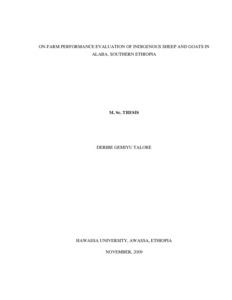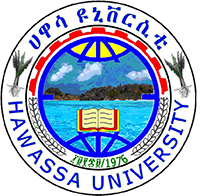Resource information
A flock monitoring study on 60 households as undertaken from October 2008 to September 2009 to measure productive and reproductive performances; determine socioeconomic benefits and husbandry practices; and identify production barriers and suggest intervention options in Alaba Special Woreda. The Woreda was stratified on the basis of sheep and goat densities and the respective sites and households were selected using multistage (purposive and random) sampling techniques. Mean land holding per household was 1.5 ha. On average, a household owned 6.5 cattle, 6.1 sheep, 4.5 goats, 1.15 equines and 4.2 chickens. Hot pepper, teff and chat are the major cash sources for farmers. Small ruminant are mainly kept for income generation. Males were sold or slaughtered before attaining puberty. ‘Afelama’, a local bylaw and punishment rule, restricts movement of sheep and goats during cropping period. Sale, death, home slaughter, share holding, gifts out and predator contributed for 60.5, 13.8, 11.0, 5.2, 1.4, and 5.7% exits, respectively, in sheep flocks while the corresponding values for goats were 41.5, 17.8, 16.1, 5.9, 11.9, and 2.5%. Sheep and goats are mainly sold to purchase agricultural inputs (fertilizer and improved seeds) and is the major reason for the reported exits. Home born, purchase, shareholding, and gifts back constituted 87.1%, 10.1, 1.7 and 1.1% entries, respectively, for sheep while for goats the values were 94.4, 2.1, 2.8 and 0.7%, respectively. Most lambing and kidding occurred between March and June, the apparent peak being in May. Mean birth weight (BWT)(kg), weaning weight (WWT)(kg), Average daily gain to weaning (ADG, g), litter size, age at first parturition and parturition interval (months) for sheep were 2.30+0.03, 10.35+0.19, 89.24+1.98, 1.52+0.04, 12.43+0.1, and 9.19+0.08, respectively. The corresponding values for goats were 2.34+0.03, 9.85+0.29, 82.34+3.18, 1.47+0.04, 11.95+0.13, and 9.05+0.08 respectively. Sex, parity, litter size and season significantly (P0.05) affected BWT in sheep whereas birth type affected 90 day weight, ADG and 120 day weight. Similarly, season influenced 30 and 120 day weights significantly (P0.05). All fixed factors except sex significantly (P0.05) affected BWT in goats whereas birth type and season significantly affected weight at 30, 60, 90 days and ADG consistently while other factors affected weight at specific ages; however, the trends were not consistent. Pre-weaning mortality rate of 13.89% and 10.66% were found for sheep and goats, respectively. Mean milk yield (morning milk) of does was 150+56.03 ml. Offtake rates of sheep and goats were 41.18 and 30.37%, respectively. Small ruminant enterprise contributes 52.32% of the net total cash income obtained from livestock rearing and 24.23% of the net total agricultural cash income. The major problems for small ruminant production in the area are poor veterinary services, water and feed shortage, seasonal market fluctuations and lack of overall extension supports. Higher rate of abortions and mortality could offset the higher prolificacy of kid and lamb crops obtained. To utilize the current emerging market opportunities, attempts should be made to improve veterinary services and forage development to alleviate the losses due to co-occurrence of high parturitions during critical feed shortage time. Efforts should also be made to optimize female reproduction and increase lamb and kid output. To select outstanding males from the local genotypes, breeding strategy should be devised. Further study is needed to identify the milking potential of the Does and cost-effective feeding strategy from locally available feeds for finishing animals in the area.



